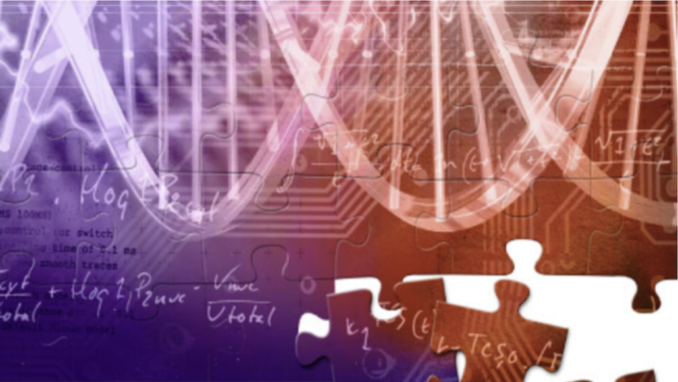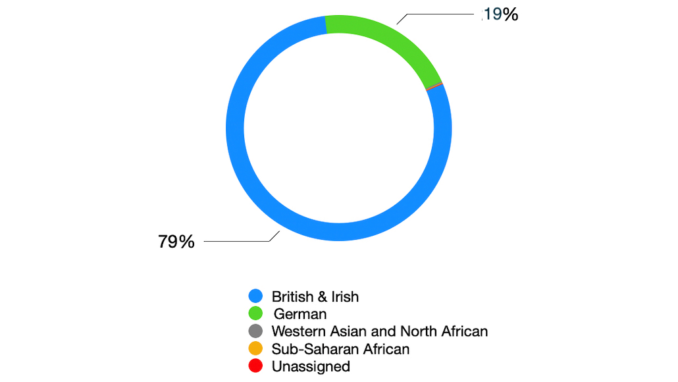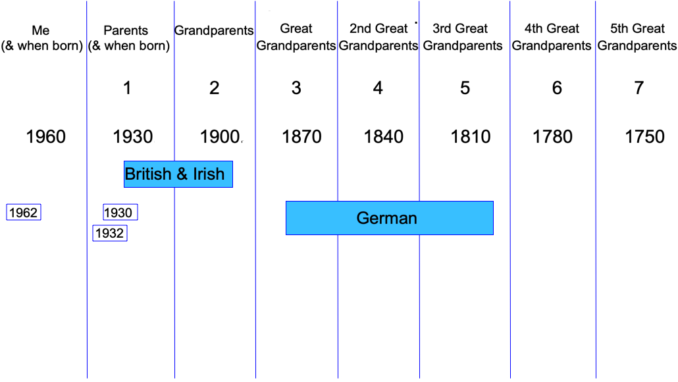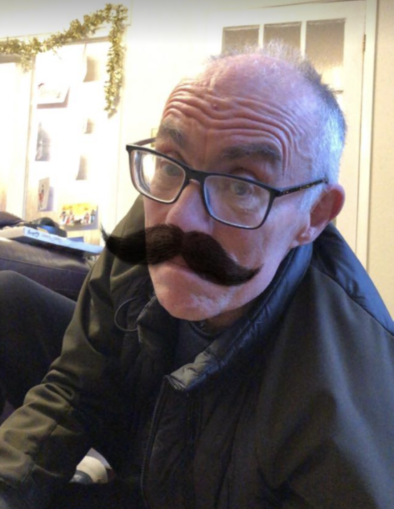
DNA at ICSB 2008,
Dunk – Licence CC BY-SA 2.0
Not who I think I am
Oh, dear. Be careful what you wish for. Let sleeping dogs lie. Unexpected consequences. Every family holds its secrets – except yours and mine. All is not what it seems. I am not the person I think I am. Upon investigation, my ancestry moves closer to a foreign shore, far from what I assumed to be my own Debatable Lands. Not that my new kith and kin have much of a coastline. Puffins may recall I received only one present at Christmas. At the time I suspected I’d been naughty but, on reflection, it might have been something my ancestors did. The one present was a gene testing kit, completed with over-enthusiasm and sent off in ominous haste. To compound the error, I wrote about it.
Expecting God, nature, Darwin, Watson & Crick to announce me Englishman Number 00001, the results proved a bit of a surprise. It turns out the tinged don’t bunch around me in church because of a hint of a benign district commissioner from a sun-baked parish in a red-painted part of the globe. Far from it. They’re more likely pleading on behalf of a loved one sent to a camp.
One genetic heat map generated by my bottle full of spit (via a chemical process too complicated for me to comprehend) and cheerful displayed on one of those horrible things called mobile phone apps, shows my family history hovering over the mellow pasture lying between the Lake District and the Solway coast. This is where I assumed my forebears have tended the land for countless millennia after arriving by as straight a line as possible from the Garden of Eden.
The genetic connections fan out from Cumbria with ‘highly likely’ matches being designated to Northern England, North Central Ireland, North East England and Northern and Central Scotland. By the time the North Midlands are reached (which one assumes to mean the Stokies), the app reduces my chromosomes to ‘not detected’.
But another heat map emerges. One in which the warmth likely billows from blast furnaces along the Ruhr and Rhine. A dark cloud of my amino acids hovers over Germany. According to the mocking genes, I’m a Wolfgang von Goethe as well as a Wordsworth, a Bertolt Brecht as well as a Melvyn Bragg, Saarbrücken as well as Sellafield and, whisper it on the windswept terraces, Berchtesgaden as much as Brunton Park.

© Always Worth Saying 2023, Going Postal
Let that sink in. And breathe a sigh of relief. It’s to be expected. We are a Northern European people. The Anglo-Saxons settled here in the Early Middle Ages. In Elizabethan times, the Lake District and Northern Pennine’s natural gifts, gouged to the surface by ancient glaciers, tempted Good Queen Bess herself to recruit German miners.
If you think Cheshire footballers have pleasant houses, marvel at the 18th-century mansions along the Eden Valley where pastures of verdant crops and thriving beasts rise to crags exposing runs of lead and silver. At a mere 19%, I’m probably less German than Churchill, Earl Haig, Bomber Harris and Stan Boardman.

© Always Worth Saying 2023, Going Postal
Unfortunately, in the suspiciously Teutonic thoroughness with which I often research my prejudices in order to prove myself right, I discovered it doesn’t work like that.
Anglo-Saxons
Let’s start with the Anglo-Saxons while keeping in mind how the gene company do their research and make their comparisons. Reference to the app shows, as per Figure 1, my 19% of German centres upon North Rhine Westphalia, is less so in Lower Saxony and Bavaria, and not at all in other parts of Germany and neighbouring Austria, Belgium, France, Luxemburg, Netherlands and Switzerland. Anglo-Saxon immigrants to England came from the areas of the near continent bounding the North Sea and included Jutes, Angles, Saxons, Frisians and Franks, peoples who originated in an arc from Denmark round to Pays de Calais.
A 2016 study published in Nature Communications journal claimed on average 25%-40% of the ancestry of modern Britons is attributable to the Anglo-Saxons. Therefore, because of the passage of time and the quantity of settlers involved, those genes are now British genes – especially East of England British genes – and will show up in a comparative DNA test as matching other British people, not Germans.
Elizabethan miners
German miners worked in the Lake District at the invitation of Queen Elizabeth I. According to a piece on the BBC website,
In the 1500s, England desperately needed copper, for the brass-making industry, for coinage to mix with silver and to make bronze for canons. Sheet copper was also used in battery works, workshops which turned the copper into a variety of utensils. Later it was used for ships hulls as a streamlining crude armour plate.
The expertise of the German miners was far more advanced than that of the English, both in the underground work of tunnelling, pumping and hauling to retrieve the ore but, more importantly, in the art of separating and smelting the copper. In the 16th Century, the Germans led the world in mining technology.
The article goes on to explain the incomers toiled underground at Caldbeck, Goldscope near Keswick and at Coniston. The Keswick contingent numbered 200 and arrived in 1564. Their presence became fraught. The following year, Leonard Stoulz died after being beaten by a mob of locals. However, during the first year, 14 local girls married Germans. The parish baptisms for Crossthwaite show 176 children with German fathers in the nineteen years between 1565 and 1584.
In 1627, similar records for Heversham in Westmoreland show a Thomae baptising his first son as Thomas, an anglicised version of the father’s German name. One of his daughters is named Agneta, another German name. Some of Thomas’ children are also given German names but by this generation, the surname has been anglicised to my own unusual Debatable Lands family name. Both in miles and years, the Hevershams are too far away from the Coniston miners for Thomae to have been one of them, but the dates and distances are close enough for him to be a son or grandson of such. I can’t prove a connection between myself and my Heversham namesakes and anyway, their Germanness is too distant. As the BBC also mentions,
‘As time elapsed, the Germans fully integrated with the English community.’
Which means the genes integrated too. If I am a direct descendant of Thomae or any of those other Germans, they would be about 12 generations distant. One of 4,096 ancestors from those days. With 50% of your genes coming from each parent (therefore 25% from each grandparent etc), by the time we go back 12 generations only 0.22875% of the DNA comes from one ancestor.
Beyond my calculation, real-life genetics is more complicated. For instance, in those days and in places like Cumberland and Westmoreland, the number of ancestors would be reduced as couples might be marrying 2nd, 3rd or more distant cousins. However, we can say a genetic share of 19% is too large to be attributed to a 16th-century ancestor. Having demolished my own uniquely identifiable Anglo-Saxonness and German miner’s heritage, where does that take me? Back to the app, that’s where.
A German in the nest
Fortunately, such generational calculations are made by the gene testing company and can be shown at the click of a button. I have used their data to create Figure 3 (below). Eagle-eyed Puffins will realise they’ve put 30 years between the generations whereas I assumed 25 when calculating back to Elizabethan times. No matter.

© Always Worth Saying 2023, Going Postal
The genes suggest a German ancestor as a great-grandparent, great-great-grandparent or great-great-great-grandparent, therefore between three and five generations ago. Through our family tree, kept on an online service, I have added to my own copy of the above graphic the relevant people back to my 32 three times great-grandparents.
All the known names and birthplaces are from Cumbria or close by, certainly English or Scottish. That said, a number of gaps are worth investigating on my mother’s side. The app also connects me to recent relatives who have also done the test and who, until now, I knew nothing of. In among the Schiessers, Shoemakers, Fisher-Kurks, Boesels, Schlesingers and Wiests, appear the descendants of two of my mother’s cousins who emigrated to the Pacific Northwest of the United States.
One of my generation is 26% German (to my 19%) and a young lady of the following generation is 4.5% German, identical to my oldest son who has also been tested. The net closes! My next step must be to contact my second and third cousins in America and pick their brains. No matter what the outcome, three things are certain. Firstly, I shall keep Puffins informed, secondly, I’m not quite the person I thought I was, and finally, from some angles, I do resemble a certain type of German.

© Always Worth Saying 2023, Going Postal
© Always Worth Saying 2023


